This post was written by Lorraine Finch ACR. Lorraine is an accredited conservator of paper and photographs.
The way we handle photographs can speed up their eventual demise and can result in them becoming completely beyond use.
If you look at your photographs, evidence of bad handling during their life is obvious. Can you see cracks, tears, nicks, dents, mould, stains or loss of the image?
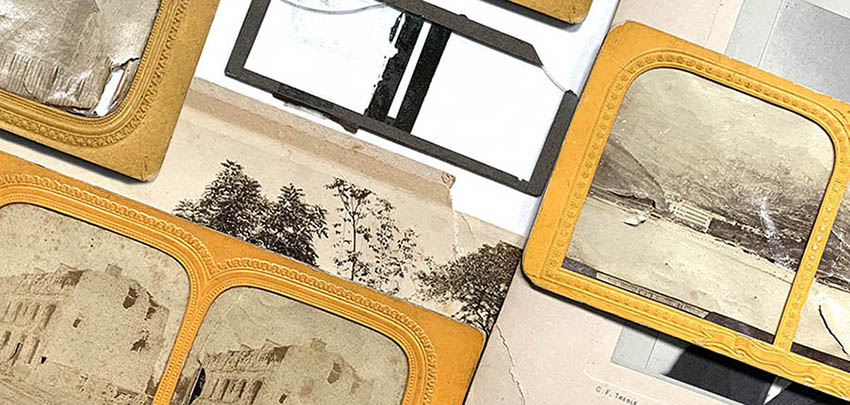 This damage may not have been obvious when it was first caused because damage caused by poor handling is often cumulative. A little bit of care, and good handling will help your photographs to last much longer.
This damage may not have been obvious when it was first caused because damage caused by poor handling is often cumulative. A little bit of care, and good handling will help your photographs to last much longer.
Here’s a guide on how to handle your photographic collection correctly:
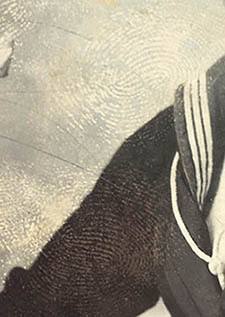
Let's deal with the thorny issue of gloves first...
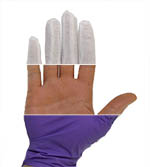 There is a great deal of misinformation and misunderstanding circulating about whether you should or should not wear gloves, and, if you should wear gloves, which type you should wear. So, should you handle photographs with:
There is a great deal of misinformation and misunderstanding circulating about whether you should or should not wear gloves, and, if you should wear gloves, which type you should wear. So, should you handle photographs with:
- clean, dry hands?
- wearing cotton gloves?
- wearing latex gloves?
- wearing nitrile gloves?
With photographs, you should always wear nitrile gloves or finger cots(Click here to view).
Your skin, even when just washed, produces oils and perspiration which leave traces on your photograph which only become evident over time (See example photo: right). The oils and perspiration from your skin also provide food for mould and insect pests.
Cotton gloves are not recommended because:
- they reduce your dexterity
- they deposit fibres onto your photograph
- they can catch on the edges of your photograph and cause tears and lift emulsion
- grease and oils from your hands will eventually penetrate through the fabric, and it becomes as if the gloves weren't there
- Gloves become dirty with use and transfer dirt from one photograph to another
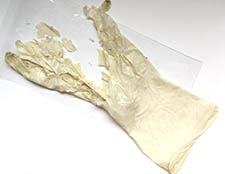
Latex gloves are not recommended because:
- they contain sulphur which will be deposited on your photograph which will damage your photograph over time
When wearing your gloves remember to not touch your face or other parts of the body as this will transfer oils and perspiration from your skin onto the gloves, and then onto your photograph.
An interesting point to remember, is that gloves also protect you. Some people can suffer from dermatitis, skin irritations and allergic reactions when handling photographs.
Getting started and few general helpful handling hints ...
- Prepare a clean and adequately large work surface before starting. Avoid using chemical cleaners on the surface, water and elbow grease should be enough. Make sure the surface is dry before you put anything onto it
- Always place your photograph image (emulsion) side up
- Try not to touch the emulsion surface
- Be careful not to stack your photographs on top of one another
- Avoid resting or leaning on your photographs
- Always use a pencil to take notes. It's far easier to remove an accidental pencil mark than one made with ink
- Make your notes on paper laid on the work surface, not on top of your photograph
- Use a copy whenever possible
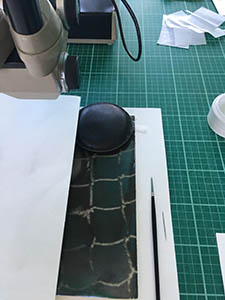
- Sticky notes should not be used on your photographs. They can lift the emulsion, will remove paper fibres, and leave a residue which will yellow over time and stain your photograph
- Staples, pins, paper clips, rubber bands and adhesive tapes should not be used on your photographs
A little more about your work surface ...
I always cover any surface that I'm working on. I normally use unbleached cotton blotter. This provides a soft, removable surface.
I am always careful to push the blotter away from the edges of my work surface to prevent the blotter from being knocked and sending everything crashing to the floor.
On occasions, usually when I'm working with glass or ceramics, I will place a soft spongy material under the blotter like this foam.
You may want to cover your work surface. You can use blotter or an inexpensive paper such lining wallpaper, which you should remove when it becomes dirty and worn. If you want to fix the paper to the table, make sure that you tape it to the underside of the table. You don't want any sticky tape sticking to your photographs.
Moving photographs …
Your clean work surface is waiting and you are ready to start looking through your photographs. You might be looking through your family photographs or you might have a small collection. You could have just photographs on paper, or you might have a mix of photographs on glass, metal and paper. Whether you have a small, large, simple or mixed collection, you should ensure that your photographs are supported when you move them.
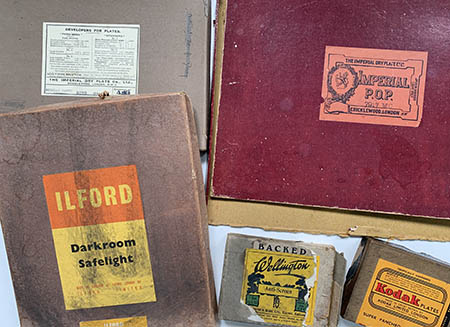 Walking around with your photograph/s unsupported in your hands is asking for trouble. It is all too easy to walk into somebody, or something, resulting in photograph/s being squashed, creased, or smashed. It is easy to drop things unintentionally, something you wouldn't want to do with your photographs on glass.
Walking around with your photograph/s unsupported in your hands is asking for trouble. It is all too easy to walk into somebody, or something, resulting in photograph/s being squashed, creased, or smashed. It is easy to drop things unintentionally, something you wouldn't want to do with your photographs on glass.
Be really careful moving boxes. The bases or sides can easily become detached; particularly so with the old boxes (like those shown in the image) that you usually find photographic collections stored in.
Please be careful of yourself when lifting. Boxes of photographic material, especially glass plates, can be very heavy. Some boxes of glass plates can even exceed the Manual Handling Regulations guide limits!
For a range of photographic storage boxes and albums click here.
Using two hands to hold a photograph, or photograph in an envelope or box, place it onto a sturdy board, keep one hand on it whilst you move it to prevent it sliding and carry it to your work surface. You can leave your photograph on the board whilst you are looking at it.
For a sturdy board, I use offcuts of mount board (100% museum cotton mount board), generally those which have been discarded after making a window mount.
Any board that you use should not transfer any dust or dirt onto your photograph, or cause damage to it in any way.
A few points about glass …
 One of the great points about using a board to move and support your photographs, is that it prevents any issues with glass plates becoming 'stuck' to your work surface. If you put a glass plate directly onto a hard surface it can be very difficult to remove. In some cases, it feels like the plate has been glued to the surface!
One of the great points about using a board to move and support your photographs, is that it prevents any issues with glass plates becoming 'stuck' to your work surface. If you put a glass plate directly onto a hard surface it can be very difficult to remove. In some cases, it feels like the plate has been glued to the surface!
If you are handling at a lot of glass plates you may want to make a 'cushion'. This is easy to make (see image). You make it from a piece of sturdy board, covered with unbleached calico which is then covered with spider tissue. The spider tissue can be removed and replaced when it becomes dirty and worn.
Writing notes on your photographs
It is better to not make notes on your photographs. Instead you should make notes on the paper envelopes. If you need to make notes on your photographs on paper, place it face down onto a sheet of glass and use an HB pencil. Ink pens are not recommended because they contain solvents, accelerants and other chemicals which may damage your photograph.
A range of photograph boxes, envelopes, and other enclosures suitable for long-term storage are available to view and buy here
Final helpful handling hints …
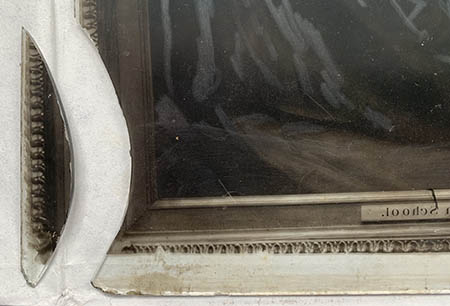
- Always remove the envelope from your photograph, not the other way around. Your photograph may be stuck to the envelope, if you try to pull it out from the envelope this may cause damage. Do not attempt to remove the photograph if it appears to be stuck. If your photograph is stuck, seek the advice of a conservator
- Be very careful when you unroll your rolls of negatives. They may have become stuck to one another, and even if they haven't, they become fragile and brittle with age. It is a good idea to unroll a little, weigh it down with a glass weight, unroll a bit more, place on another a weight and so on
- Avoid holding your negatives up to the light to see what's on them. This is when they get dropped. Always view your negatives using a light box
- Support your photographic albums to prevent damage to spines and boards
- Never pick up photographs by their corners. The boards and papers that photographs are mounted onto become brittle over time, and they may just snap off when handled by the corner. I have a large glass plate in my photographic teaching collection (shown in image) which now has a snapped off corner because it was badly handled. The student picked it up by the corner and the corner cracked off with a resounding snap. It was the best way to learn. They won't ever pick up a photograph by the corner again …
Good handling practice is essential for the long-term survival of your photographs. Without good handling your photographs have little chance of surviving intact. Good handling really is very easy to put in place. It is mostly common sense. Practice good handling whenever you use your photographs and it will become second nature.
This post was written by Lorraine Finch ACR. Lorraine is an accredited conservator of paper and photographs.
You can contact Lorraine Finch in the following ways: E: paperconservation@btinternet.com | W: www.lfcp.co.uk | T: @conserve_lfcp | Facebook: LFCandP